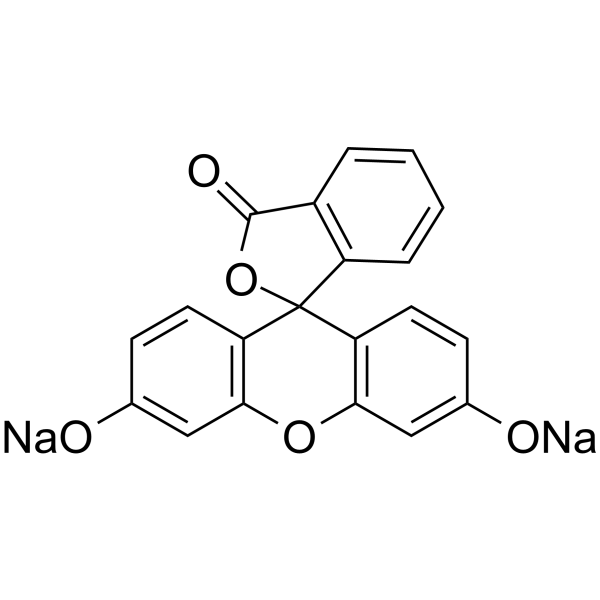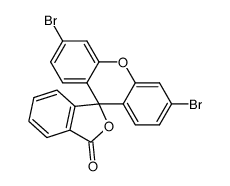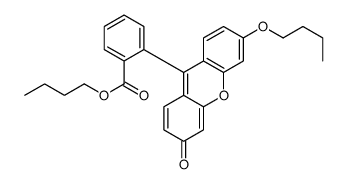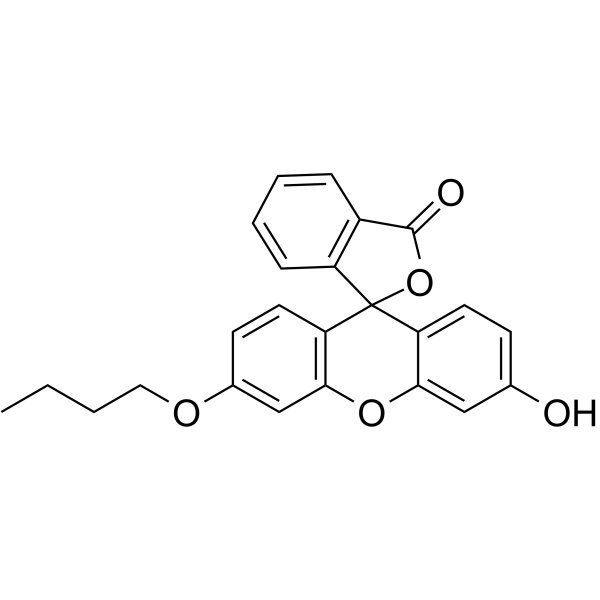Fluorescein sodium

Fluorescein sodium structure
|
Common Name | Fluorescein sodium | ||
|---|---|---|---|---|
| CAS Number | 518-47-8 | Molecular Weight | 376.270 | |
| Density | 1.601 g/cm3 (20ºC) | Boiling Point | 620.8ºC at 760 mmHg | |
| Molecular Formula | C20H10Na2O5 | Melting Point | 320 °C | |
| MSDS | USA | Flash Point | 232.6ºC | |
Use of Fluorescein sodiumFluorescein (Uranine) sodium is widely used as a fluorescent tracer in medicinal and biological applications and tumor infected tissues tracer. Fluorescein (Uranine) sodium is a representative green fluorophore that has been widely used as a scaffold of practically useful green fluorescent probes[1][2]. |
| Name | Uranine |
|---|---|
| Synonym | More Synonyms |
| Description | Fluorescein (Uranine) sodium is widely used as a fluorescent tracer in medicinal and biological applications and tumor infected tissues tracer. Fluorescein (Uranine) sodium is a representative green fluorophore that has been widely used as a scaffold of practically useful green fluorescent probes[1][2]. |
|---|---|
| Related Catalog | |
| In Vitro | Fluorescein is a synthetic organic photoactive dye compound soluble in water, alcohol and polar solvents[1]. |
| References |
| Density | 1.601 g/cm3 (20ºC) |
|---|---|
| Boiling Point | 620.8ºC at 760 mmHg |
| Melting Point | 320 °C |
| Molecular Formula | C20H10Na2O5 |
| Molecular Weight | 376.270 |
| Flash Point | 232.6ºC |
| Exact Mass | 376.032349 |
| PSA | 81.65000 |
| LogP | 4.54220 |
| Water Solubility | 500 g/L (20 ºC) |
CHEMICAL IDENTIFICATION
HEALTH HAZARD DATAACUTE TOXICITY DATA
MUTATION DATA
|
| Personal Protective Equipment | Eyeshields;Gloves;type N95 (US);type P1 (EN143) respirator filter |
|---|---|
| Hazard Codes | Xi:Irritant |
| Risk Phrases | R36 |
| Safety Phrases | S22-S24/25-S37/39-S26 |
| RIDADR | NONH for all modes of transport |
| WGK Germany | 1 |
| RTECS | LM5425000 |
| HS Code | 3204200000 |
|
~% 
Fluorescein sodium CAS#:518-47-8 |
| Literature: Xu, Qingling; Lee, Kyung-Ah; Lee, Songyi; Lee, Kyung Mi; Lee, Won-Jae; Yoon, Juyoung Journal of the American Chemical Society, 2013 , vol. 135, # 26 p. 9944 - 9949 |
|
~% 
Fluorescein sodium CAS#:518-47-8 |
| Literature: Xu, Qingling; Lee, Kyung-Ah; Lee, Songyi; Lee, Kyung Mi; Lee, Won-Jae; Yoon, Juyoung Journal of the American Chemical Society, 2013 , vol. 135, # 26 p. 9944 - 9949 |
| HS Code | 2932999099 |
|---|---|
| Summary | 2932999099. other heterocyclic compounds with oxygen hetero-atom(s) only. VAT:17.0%. Tax rebate rate:13.0%. . MFN tariff:6.5%. General tariff:20.0% |
|
Antioxidant activity of protocatechuates evaluated by DPPH, ORAC, and CAT methods.
Food Chem. 194 , 749-57, (2015) Hibiscus sabdariffa L. is a worldwide consumed plant, principally after infusion of its dried sepals and calyces, which are usually discarded. Nevertheless, they represent a potential source of natura... |
|
|
Transparent intracortical microprobe array for simultaneous spatiotemporal optical stimulation and multichannel electrical recording.
Nature Methods 12 , 1157-62, (2015) Optogenetics, the selective excitation or inhibition of neural circuits by light, has become a transformative approach for dissecting functional brain microcircuits, particularly in in vivo rodent mod... |
|
|
Brain Invasion by Mouse Hepatitis Virus Depends on Impairment of Tight Junctions and Beta Interferon Production in Brain Microvascular Endothelial Cells.
J. Virol. 89 , 9896-908, (2015) Coronaviruses (CoVs) have shown neuroinvasive properties in humans and animals secondary to replication in peripheral organs, but the mechanism of neuroinvasion is unknown. The major aim of our work w... |
| URANIN |
| URANINE |
| c.i.766 |
| D and C yellow dye No 8 |
| EINECS 208-253-0 |
| Fluorescein,disodium salt |
| Spiro[isobenzofuran-1(3H),9'-[9H]xanthen]-3-one, 3',6'-dihydroxy-, sodium salt (1:2) |
| spiro[isobenzofuran-1(3H),9'-[9H]xanthen]-3-one, 3',6'-dihydroxy-, disodium salt |
| uranineo |
| Yellow No. 8,NaFl,NaFluo |
| Acid Yellow 73,D&C |
| MFCD00167039 |
| ful-glo |
| fluoresceine disodium salt |
| Fluorescein Sodium Salt |
| furanium |
| Fluorin |
| 9-(2-Carboxyphenyl)-6-hydroxy-3H-xanthen-3-one disodium salt |
| YELLOW 8 |
| Sodium 3-oxo-3H-spiro[isobenzofuran-1,9'-xanthene]-3',6'-bis(olate) |
| Disodium 3-oxo-3H-spiro[2-benzofuran-1,9'-xanthene]-3',6'-diolate |
| Fluorescein Disodium Salt |
| Fluorone |
| Acid yellow 73 |

![3',6'-dibromo-3H-spiro[benzo[c]thiophene-1,9'-xanthen]-3-one structure](https://www.chemsrc.com/caspic/096/1443665-54-0.png)
 CAS#:131205-61-3
CAS#:131205-61-3 CAS#:335193-91-4
CAS#:335193-91-4 CAS#:15086-94-9
CAS#:15086-94-9
